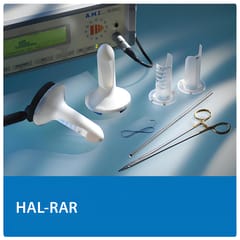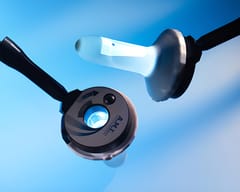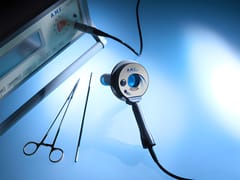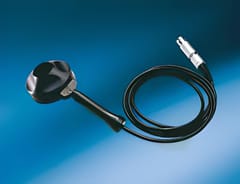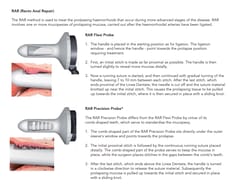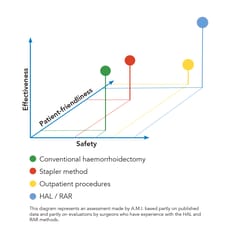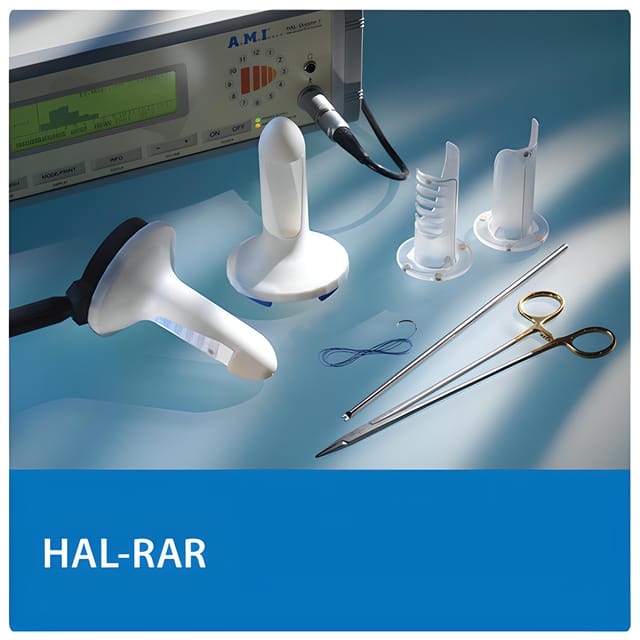Show cart summary: 0 Items
Please Add Some Items
A.M.I.® HAL / RAR System
- Safe, gentle and effective treatment for all grades of haemorrhoids in one procedure
- Doppler ultrasound technology for the precise, customised detection of haemorrhoidal arteries in each patient
- Handle with high-performance LED's for bright, even illumination and a clear view
HAL (Haemorrhoidal Artery Ligation)
The HAL method is suitable for treating low to medium grade haemorrhoids, and is extremely effective in addressing the symptoms of haemorrhoidal disease. The ligations serve to reduce the arterial blood supply, causing the haemorrhoidal cushions to shrink back to normal size. This method can be carried out with ease using the RAR Flexi Probe.
- The handle with the RAR Flexi Probe is introduced into the rectum, then rotated slowly to search for arteries. The loudest Doppler signal indicates the centre of the artery.
- Once the first artery has been found, it is ligated using an A.M.I. Suture with 5/8 needle.
- The handle is then turned again to locate further arteries. Once found, each artery is ligated as described in step 2.
As a rule, between five and eight arteries will be found during the procedure. However this number can vary from patient to patient, and will also depend on the severity of the haemorrhoids in each case.
RAR (Recto Anal Repair)
The RAR method is used to treat the prolapsing haemorrhoids that occur during more advanced stages of the disease. RAR involves one or more mucopexies of prolapsing mucosa, carried out after the haemorrhoidal arteries have been ligated.
- RAR Flexi Probe
- The handle is placed in the starting position as for ligation. The ligation window - and hence the handle - point towards the prolapse position requiring treatment.
- First, an initial stitch is made as far proximal as possible. The handle is then turned slightly to reveal more mucosa distally.
- Now a running suture is started, and then continued with gradual turning of the handle, leaving 7 to 10 mm between each stitch. After the last stitch, which ends proximal of the Linea Dentata, the needle is cut off and the suture material knotted up near the initial stitch. This causes the prolapsing tissue to be pulled up towards the initial stitch, where it is then secured in place with a sliding knot.
- RAR Precision Probe
The RAR Precision Probe differs from the RAR Flexi Probe by virtue of its comb-shaped teeth, which serve to standardise the mucopexy.
- The comb-shaped part of the RAR Precision Probe sits directly under the outer sleeve’s window and points towards the prolapse.
- The initial proximal stitch is followed by the continuous running suture placed distally. The comb-shaped part of the probe serves to keep the mucosa in place, while the surgeon places stitches in the gaps between the comb’s teeth.
- After the last stitch, which ends above the Linea Dentata, the handle is turned in a clockwise direction to release the suture material. Subsequently the prolapsing mucosa is pulled up towards the initial stitch and secured in place with a sliding knot.
Advantages of HAL & RAR
Since the introduction of these minimally-invasive methods, many tens of thousands of patients have been treated with them and excellent results achieved in terms of effectiveness, patient-friendliness and safety.
Effective
- Treatment of the three main symptoms
- Bleeding, itching and pain - with HAL
- Treatment of the prolapse with RAR
Patient-friendly
- Minimal pain
- Quick recovery
Safety
- Fewer intra-operative complications
- -Fewer post-operative complications
Technical Specification
Brand – AMI
Number of Transducer Socket – 2 No
Probe – Linear, Micro Convex
Connectivity – DICOM
Maximum Depth of Field – 30mm
Range – Premium to Basic
Probe Frequency – 2 MHz, 3 MHz
- Home
- A.M.I.® HAL / RAR System
A.M.I.® HAL / RAR System
Your enquiry has been sent
Product Enquiry Form
Leave us a message for futher information.
- Safe, Gentle & Effective Treatment For All Grades of Haemorrhoids In One Procedure
- Doppler Ultrasound Technology For The Precise, Customised Detection of Haemorrhoidal Arteries In Each Patient
- Handle with High-Performance LED's For Bright, Even Illumination & A Clear View
- Minimal Pain & Quick Recovery
- Fewer Intra & Post Operative Complications
Estimated Delivery Time:_5 to 7 Working Days
| VARIANT | SELLER | PRICE | QUANTITY |
|---|
Specifications
| Brand | AMI |
Description of product
A.M.I.® HAL / RAR System
- Safe, gentle and effective treatment for all grades of haemorrhoids in one procedure
- Doppler ultrasound technology for the precise, customised detection of haemorrhoidal arteries in each patient
- Handle with high-performance LED's for bright, even illumination and a clear view
HAL (Haemorrhoidal Artery Ligation)
The HAL method is suitable for treating low to medium grade haemorrhoids, and is extremely effective in addressing the symptoms of haemorrhoidal disease. The ligations serve to reduce the arterial blood supply, causing the haemorrhoidal cushions to shrink back to normal size. This method can be carried out with ease using the RAR Flexi Probe.
- The handle with the RAR Flexi Probe is introduced into the rectum, then rotated slowly to search for arteries. The loudest Doppler signal indicates the centre of the artery.
- Once the first artery has been found, it is ligated using an A.M.I. Suture with 5/8 needle.
- The handle is then turned again to locate further arteries. Once found, each artery is ligated as described in step 2.
As a rule, between five and eight arteries will be found during the procedure. However this number can vary from patient to patient, and will also depend on the severity of the haemorrhoids in each case.
RAR (Recto Anal Repair)
The RAR method is used to treat the prolapsing haemorrhoids that occur during more advanced stages of the disease. RAR involves one or more mucopexies of prolapsing mucosa, carried out after the haemorrhoidal arteries have been ligated.
- RAR Flexi Probe
- The handle is placed in the starting position as for ligation. The ligation window - and hence the handle - point towards the prolapse position requiring treatment.
- First, an initial stitch is made as far proximal as possible. The handle is then turned slightly to reveal more mucosa distally.
- Now a running suture is started, and then continued with gradual turning of the handle, leaving 7 to 10 mm between each stitch. After the last stitch, which ends proximal of the Linea Dentata, the needle is cut off and the suture material knotted up near the initial stitch. This causes the prolapsing tissue to be pulled up towards the initial stitch, where it is then secured in place with a sliding knot.
- RAR Precision Probe
The RAR Precision Probe differs from the RAR Flexi Probe by virtue of its comb-shaped teeth, which serve to standardise the mucopexy.
- The comb-shaped part of the RAR Precision Probe sits directly under the outer sleeve’s window and points towards the prolapse.
- The initial proximal stitch is followed by the continuous running suture placed distally. The comb-shaped part of the probe serves to keep the mucosa in place, while the surgeon places stitches in the gaps between the comb’s teeth.
- After the last stitch, which ends above the Linea Dentata, the handle is turned in a clockwise direction to release the suture material. Subsequently the prolapsing mucosa is pulled up towards the initial stitch and secured in place with a sliding knot.
Advantages of HAL & RAR
Since the introduction of these minimally-invasive methods, many tens of thousands of patients have been treated with them and excellent results achieved in terms of effectiveness, patient-friendliness and safety.
Effective
- Treatment of the three main symptoms
- Bleeding, itching and pain - with HAL
- Treatment of the prolapse with RAR
Patient-friendly
- Minimal pain
- Quick recovery
Safety
- Fewer intra-operative complications
- -Fewer post-operative complications
Technical Specification
Brand – AMI
Number of Transducer Socket – 2 No
Probe – Linear, Micro Convex
Connectivity – DICOM
Maximum Depth of Field – 30mm
Range – Premium to Basic
Probe Frequency – 2 MHz, 3 MHz

